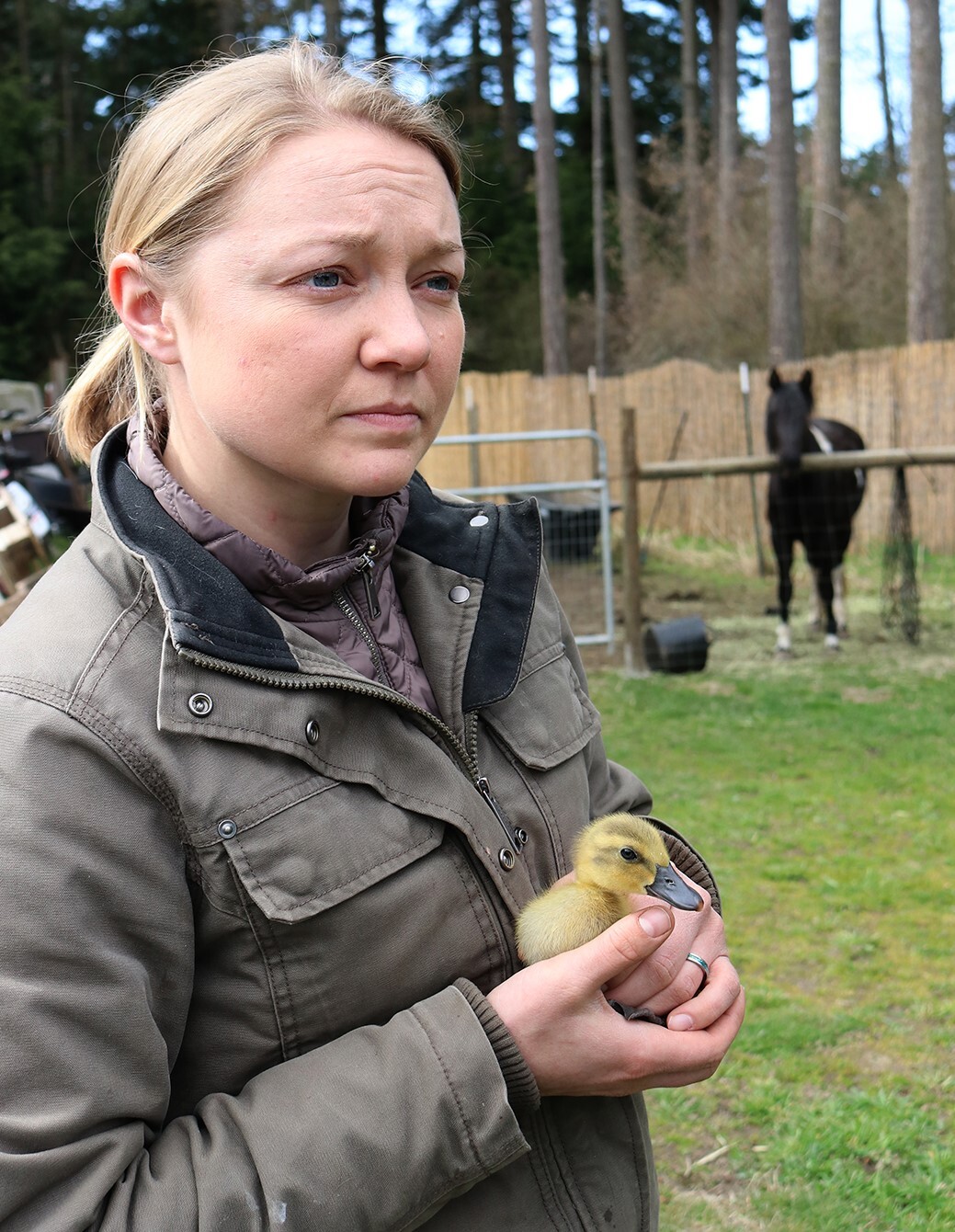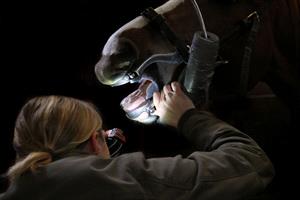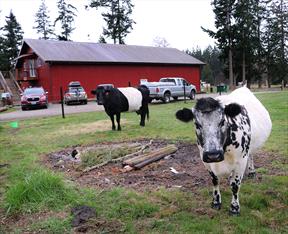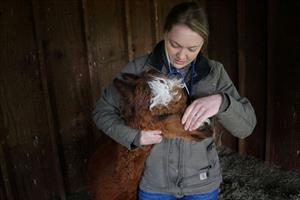Dr. Ana Kidder

Photo by Jon Williams
During a farm call to examine a horse, Dr. Ana Kidder pauses to cuddle a duckling named French Fry. Appointments in the field often resemble social calls, complete with client show-and-tell.
Dr. Ana Kidder arrived at work on a cold, overcast early spring morning wearing an eager expression that belied the fact that she'd been in this building late the previous night, performing an emergency tail amputation on a cat.
The 30-year-old veterinarian made fast work of a breakfast burrito reheated in the clinic microwave and washed it down with a 16-ounce coffee. With similar dispatch, Kidder hopped into her truck, the day's itinerary of farm calls in her head and two cellphones on the front seat. A pair of cows in the clinic pasture sent her on her way with a chorus of moos.
While the majority of Kidder's peers are employees at veterinary hospitals, many owned by large corporations, she has forged a different path. Last January, less than three years after graduating from veterinary school, Kidder bought a mixed animal practice on Whidbey Island in Washington. She has been the sole practitioner since September.
Her trajectory is out of step with current trends in the profession. Clinic ownership by veterinarians has declined steadily over the past 15 years. Only 9% of veterinarians age 39 and under were owners in 2018 (the most recent year for which figures are available). Individual proprietorships accounted for 12.1% of clinic ownership in 2020, down from 22.9% in 2009, according to data from the American Veterinary Medical Association.
Kidder said ownership has been possible for her because "things have lined up for me," including finding an invested mentor right out of veterinary school, having a supportive husband and extended family, and her own willingness to make short-term sacrifices for a long-term goal.
"Did I realize how tough it would be?" she mused. "No. Is it what I wanted? Yes."
'The number one rule on farm days: lots of coffee'
Kidder pulled into Wildwood Farm, where rolling paddocks hinted at its past as a large thoroughbred breeding operation. She was there to see Lady, a 5-year-old chestnut mare.
Jenny Rector, one of Kidder's two veterinary assistants, pulled up in her own truck. She'd follow all day, accompanied by her two French bulldogs. Kidder also employs a practice manager and veterinary technician — all four staff members at Central Whidbey Veterinary Services stayed through the change in ownership. Come summer, a graduate of the Mississippi State University College of Veterinary Medicine will join the team as an associate.
Working under a gray sky, Kidder methodically worked through the exam list — lungs, abdomen, eyes, nose, mouth, limbs, feet — as the owner held Lady's lead, answered questions and volunteered details about the once wild horse that had been rounded up and rescued from a kill pen in Eastern Washington a couple of years ago.
Kidder observed a consistent head bob when Lady stepped on her left front foot, a sign of lameness. She referred the owner to a nearby equine sports medicine practice for further evaluation, including a possible ultrasound.
Preventive dentistry was also on the agenda and is a big part of Kidder's work with horses. When horses chew, their jaw moves in an oval pattern rather than straight up and down. Unevenness of the bite or the meeting of incisors can cause irregular wear on chewing teeth. Because horses' teeth continue to erupt throughout their lives, the wear patterns can cause sharp points that cut the cheeks or tongue and also can exacerbate the development of high and low spots, creating gaps where feed can settle and cause decay.
Floating, as it's known, is the use of a file or Dremel-like tool to reduce the high spots and smooth out the sharp points.
Equine teeth exam

Photo by Jon Williams
Kidder peers into the mouth of a mare named Lady, using a speculum to maintain an "ahh" position.
In the stall, Kidder injected Lady with the animal sedatives xylazine and detomidine. "The number one rule on farm days," Kidder told a reporter tagging along, is "lots of coffee and lots of xylazine."
Lady's eyelids soon fluttered and her head bobbed. With a large syringe, Kidder squirted antiseptic rinse into her mouth. Then, she fitted a speculum into the mare's mouth and ratcheted it open before examining the teeth in the light of a headlamp. So far, so good, but when the doctor revved her battery-powered float, the motor whirred weakly. Lady backed away with the unsteady gait of a drunk.
Rector soothed and distracted the horse while Kidder fussed with the machine — until conceding it was broken. She took the setback in stride and promised to waive the $80 farm visit fee when she would return with the repaired tool.
The appointment had taken almost two hours, not including getting there. The invoice wouldn't even cover expenses. Plus, the broken float meant other dental appointments for the day had to be canceled.
"Farm call days aren't always profitable," Kidder said. "There is not a lot of money in livestock, but someone has to do it." She relies on more efficient days in the clinic with dogs and cats to underwrite these outings.
Her practice is about 75% small animals, mostly dogs and cats. The rest of her patients are horses, goats, sheep, cattle, pigs, alpacas and other animals raised as 4-H projects or by small producers and kept on hobby farms and as pets. She generally schedules four in-clinic days and one day of farm calls each week — plus after-hours emergencies, of which there are many.
'Everything just happened at the right time'
CharlotteAndMartha

Photo by Jon Williams
Central Whidbey Veterinary Services is housed in a 1,000-square-foot building constructed by the previous owner. The cows out front belong to Kidder. She bought the belted cow, Martha, as a present to herself after graduating from veterinary school in 2019.
Kidder's family has lived and farmed on Whidbey since the late 1800s. The 40-mile-long glacier-carved island in Puget Sound sits between mainland Washington to the east and the Olympic Peninsula to the west. Gambrel-roofed barns sit in lush pastures, driftwood studs pebble beaches, and when the views aren't socked in with clouds, they usually feature snow-capped mountains in almost all directions.
Kidder well knows how the island population has evolved from a mostly fishing and farming community to become a vacation-home hub and weekend getaway for Seattle, which is about 30 miles southeast as the seagull flies.
Her husband, Clint Kidder, is also from the area. They married after her first year at Washington State University College of Veterinary Medicine in Pullman, and he moved there with her. They planned to return home after graduation.
Near the end of her fourth-year clinical training, Kidder emailed the only owner of a mixed animal practice on the island, Dr. Robert Moody in Coupeville. Wanting to work with animals large and small, she asked if he'd take her on for a two-week externship. He agreed without ever meeting her. They hit it off, and she returned as an associate after graduation in 2019.
When Kidder joined Moody, he was nearly 70 and looking toward the exit. When he hired her, he asked if she'd be interested in buying the practice. Kidder had been thinking of running her own mobile large animal practice, but she soon came around to the idea of owning a fixed facility. They closed the $600,000 deal in January 2022, with Moody providing the financing for six years. He has since moved out of state.
"I don't know what his plan would have been for selling the practice if I hadn't come along," she said. "I think everything happened just at the right time for him to be able to look towards retirement and have the practice continued and for me to be able to come home. It was phenomenal."
The 1,000-square-foot clinic was built by the previous owner for small animal practice. Kidder is planning soon to break ground 16 miles away on a bigger facility that can accommodate large animals, too.
'I don't even flinch now when my phone rings'
No power tools were needed for the second appointment. Jimmy, a 2-year-old Nigerian-Boer cross goat with swooping horns, yellow eyes and an impressive goatee, was up for castration. The main tool that would be required was a manual emasculator, which looks a little like pliers and crushes the spermatic cord that carries blood from the abdomen to the testicles.
Anticipating a stinky operation, Kidder donned a full set of coveralls over her jeans and vest. Rector pulled on an extra pair of pants and drew shoulder-length gloves over her shirt sleeves. Both Rector and Kidder also wore latex gloves.
The wisdom of their precautions became clear when the buck emerged from a trailer where he'd been kept separated from three does. He reeked of the musky urine that he'd sprayed on his face, beard, front legs and chest in an effort to attract a mate.
Kidder_with_goat

Photo by Jon Williams
Kidder injects Jimmy, a Nigerian-Boer cross goat, with a sedative and anesthetic before castrating him.
Kidder injected the goat with a mix of xylazine and the anesthetic ketamine, and Jimmy was soon laid out in the grass with his owner holding his head and Rector keeping his back legs out of Kidder's way. After shaving and cleaning his groin with an antiseptic wash, she cut a small incision in his scrotum, pulled out a testicle, and used the emasculator to crush the cord. She repeated the process, tying off the ends of the severed cords with a ligature.
Within about 30 minutes, from donning coveralls to giving Jimmy a parting shot of tetanus antitoxin, Kidder was helping load the woozy goat back in the trailer, where he already seemed to be finding his feet.
Back on the road, a pair of veterinary trucks like Kidder's approach from the opposite direction. They were equine sports medicine veterinarians from Mount Vernon, a city on the mainland. Kidder stopped for a friendly hello.
She doesn't see colleagues as competitors, she said, since there is more than enough work for everyone, and each practice provides a unique set of services.
Kidder estimates 10 veterinary practices, including those of mobile and semi-retired veterinarians, are based on the island, which has a population of about 70,000.
Kidder said Moody's practice began to grow exponentially when she came aboard in 2019 — driven, at first, by having a young associate on board. She put in 80-hour weeks in the first year and was able to retire her school debt of $25,000.
(That's a lot lower than most of her peers. In 2022, one in three graduates had amassed $200,000 or more in veterinary school debt, according to an AVMA survey. Kidder's relatively low debt was due to several factors: Savings and student scholarships got her through undergraduate school without student loans, her grandparents helped with a year of tuition, and her husband worked full-time to cover their cost of living while she was in school.)
With the Covid-19 pandemic, things really took off.
"We used to be a Podunk island. We used to be full of dairy farms. We had mom-and-pop diners. That's changed," she said. "During Covid, the number of pets on the island went way up as the number of people living here went way up. People are showing up on Whidbey and there are [few veterinarians] taking new clients." Kidder is not taking new small animal clients but she is still taking on large animals because of the shortage of large animal veterinarians, in particular.
She felt the full brunt of the pandemic boom when Moody retired.
"I was just kind of stumbling around in the dark for a few months, trying to make sure that we had everything taken care of," she said. "My mentor, bless his heart, was a wonderful vet but not a very organized businessperson. We've had to do so many things from the ground up. If it wasn't for my banker, my financial adviser and my staff, we would be sunk."
Making a challenging situation more difficult, until last year, her practice provided on-call emergency service for large and small animals to anyone who called — the only practice on the island to do so. "I don't even flinch now when my phone rings in the middle of the night. I've become numb to it a little bit," she said.
Now, she tries to limit after-hours service to established clients, though she's not always successful.
"I get phone calls all the time, and when you answer the phone in the middle of the night and somebody's crying on the other end, it's really hard to say, 'I won't see you,' " she said.
'They didn't know if it was a pet or dinner'
George the alpaca

Photo by Jon Williams
A senior alpaca named George is a perfect gentleman — not spitting — during a wellness exam with Kidder.
The day ticked along with an increasingly adorable patient list. Kidder checked in on 20-year-old alpaca named George in need of an updated prescription for arthritis medicine. The sole survivor of what had been an alpaca quartet — John, Paul, George and Norman — the coppery-haired ungulate looked a little lonely in his large, verdant pasture but was otherwise healthy for his age.
Benjamin, a 2-year-old gelding who'd been purchased from an online auction, also checked out as in good shape. But he was mouthy and prone to chomp things he shouldn't. The diagnosis was boredom. The owner hadn't begun riding Benjamin. Kidder and Rector, a horsewoman and longtime 4-H leader, encouraged the owner to lead Benjamin on trail walks and to reach out for guidance from trainers on starting him under saddle.
Advice is a big part of what the veterinary team dispenses. Kidder's found education to be a significant part of her job, especially with owners who may be new to the challenges of keeping animals on a Pacific Northwest island, like the fact that the ground is wet for most of the winter; or with people who are caring for farm animals for the first time.
She recalled doing a brand inspection to establish proof of ownership of a longhorn heifer. "There was no fenced pasture on the property, and the new owner asked if they should cut the horns," Kidder recalled, adding that longhorns are raised because of their incredible horns. "They didn't know if it was a pet or dinner."
Her role as advice-giver isn't limited to scheduled appointments. "People stop and ask you medical questions when you're in the checkout line at Home Depot," she said. "They ask you what to do with their cat's runny nose or something. You could tell them to make an appointment, or you could just sit and chat with them for a second. That's usually what we do."
'It's exciting to have the reins in my hands'
Kidder made a final visit of the day to a farm owned by an old friend of her grandmother's. Here, a 26-year-old miniature horse named Willy (best friend to another miniature horse named Wonka) had been on the schedule for a float. Kidder stopped by to peek at Willy's teeth — those he had left — to make sure a delay, owing to her broken tool, wouldn't be a problem. She didn't charge for the call.
For an associate paid on production, this stop would be a nonstarter. For Kidder, it's a perk of being an owner. She makes her own choices, and sometimes those choices mean catching up with friends who are clients, and clients who become friends, without worrying over the bottom line. She said she'd never give up this freedom to a corporate buyer.
Back at the clinic parking area, Kidder lingered in the truck. She wanted to say something more about her career choices and the work/reward equation as she sees it. She was circling back to the topic that prompted the reporter's visit in the first place.
In February, Kidder read a commentary published by the VIN News Service written Dr. Mark Helfat, a long-time practice owner in New Jersey who argued that the soul of veterinary medicine is being lost as smaller, veterinarian-owned practices are purchased by consolidators. The commentary moved Kidder to send Helfat an email sharing why she loves having her own practice.
"[Y]esterday, I got to enjoy a cup of coffee with a longtime client [when I stopped in to] visit in between farm calls. Today, I got to visit with a client's son, who has made a remarkable turnaround from drug addiction and can hold a conversation again and crack a joke with a smile on his face. As I write this, I'm heading out the door to check on a postpartum mare on my way home because the owner is worried and I'm heading that way anyhow. The relationships in this profession and the role this clinic has played in the community keep me going."
At the end of this day, she offered a further thought.
In veterinary school, she said, there was a prevailing message that veterinarians' mental health depends on not overextending oneself. Kidder believes that work-life balance is important but worries the well-intentioned idea might dissuade young veterinarians from the tough but rewarding experience of ownership.
"I don't see my strategy of '24/7 care and no family life' as the long-term solution but a willing sacrifice as I build a practice and introduce a larger team to the equation. I would agree I don't have a healthy work-life balance right now, and life is crazy, and I would love a vacation. I recognize that. But I have a plan for making it work long-term, and it's exciting to have the reins in my hands," she said.
“I'm not judging my peers who want the security and set hours of working as an associate," she added. “The structure of the practice shouldn't define the quality of the vet, and the job title shouldn't limit job satisfaction. But I think some may be missing out."
Correction: In Mississippi, the College of Veterinary Medicine is at Mississippi State University, not the University of Mississippi, as was originally reported in error.